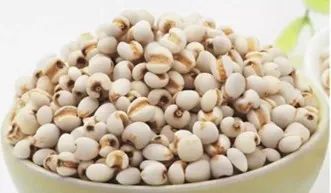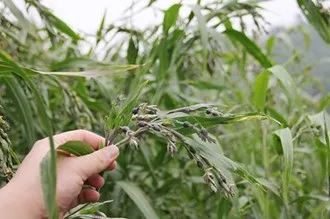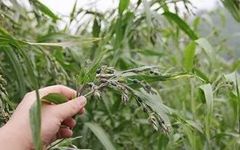
Coix Seed (Yi Yi Ren) has a long history in Traditional Chinese Medicine (TCM). It is sweet and bland in flavor, slightly cold in nature, and is known for its ability to promote diuresis and reduce swelling, strengthen the spleen and eliminate dampness, relax the muscles and alleviate pain, as well as clear heat and expel pus. It is a commonly used diuretic and dampness-eliminating herb. Due to its high nutritional value, it is often referred to as the “King of Gramineous Plants” and “The Best Rice in the World”. Its ability to dispel dampness and reduce fire has earned it the title of “Dampness-Dispelling King”. In Europe, it is known as the “Grain of Life and Health”; in Japan, it is classified as a “Cancer Prevention Food”. Today, let’s explore more interesting facts about Coix Seed.
Introduction to Coix Seed

Coix Seed, also known as Yi Mi, Tu Yu Mi, Qi Shi, Yi Zhu Zi, Cao Zhu Zhu, and Mi Ren, is a commonly used herb in TCM and a widely consumed food. Coix prefers to grow in humid areas but can withstand both flooding and drought. It typically grows near houses, in wastelands, by rivers, streams, or in damp valleys. In northern regions, it is commonly referred to as Cao Zhu Zhu, while in Lingnan (Guangzhou), it is called Lang Ya Zhu. It is an annual or perennial herb, with erect stems that can reach heights of 1 to 1.5 meters, bushy with many branches, and roots growing from the lower nodes. The leaves are alternate, with short leaf tongues and sheaths that embrace the stem. The racemes emerge from the inner side of the upper leaf sheaths, with one to several flowers clustered together. The flowers are unisexual, with both male and female on the same plant, enclosed in an oval hard bract, which gradually becomes bead-like upon maturity. The flowering period is from July to August, and the fruiting period is from September to October. In September and October, when the stems and leaves turn yellow and the fruits become brown, the plants are harvested, left standing for 3-4 days for threshing, and then the stems and leaves are removed, dried or roasted, and the bracts and seed coats are removed using dehulling machinery.
The finished Coix Seed is oval or elongated, measuring 4-8 mm in length and 3-6 mm in width. The surface is milky white and smooth, occasionally with remnants of yellow-brown seed coats. One end is blunt and rounded, while the other end is wider and slightly concave, with a light brown dot-like hilum. The back is rounded and convex, while the belly has a wide and deep longitudinal groove. The texture is firm, with a white cross-section that is powdery. It has a faint aroma and a slightly sweet taste.
Li Shizhen recorded in the Compendium of Materia Medica that Coix Seed can “strengthen the spleen and benefit the stomach, nourish the lungs and clear heat, dispel wind and eliminate dampness. It can be cooked in rice to treat cold air. When decocted, it promotes urination and alleviates heat dysuria.” In recent years, numerous scientific studies and clinical practices have proven that Coix Seed is also an anti-cancer agent, with effective components being “Coix Seed Oil” and “Coix Seed Inner Oil”. The selenium content can effectively inhibit the proliferation of cancer cells and can be used as an adjunct treatment for gastric cancer and cervical cancer. Preliminary identification shows that it can achieve a suppression rate of over 35% against cancer. No wonder there is a folk song in the Guilin area that sings: “Coix Seed surpasses Lingzhi grass, with high medicinal and nutritional value; regular consumption can prolong life and restore youth.”
Medicinal Value of Coix Seed
Coix Seed has a wide range of effects, and when combined with different herbs, it can exhibit various therapeutic benefits.
1. Promotes diuresis and eliminates dampness, primarily treating edema, urinary difficulty, and beriberi. Coix Seed is sweet and bland, promoting diuresis and strengthening the spleen, similar to Fu Ling (Poria). It is often used with other diuretic and swelling-reducing herbs, such as Zhu Ling (Polyporus), Ze Xie (Alisma), and Dong Gua Pi (Winter Melon Peel). It is particularly suitable for edema and urinary difficulty due to spleen deficiency and dampness, often combined with Fu Ling, Bai Zhu (Atractylodes), and Huang Qi (Astragalus) to enhance its diuretic and swelling-reducing effects. For beriberi, it is often used with drying and diuretic herbs, such as Wu Zhu Yu (Evodia), Ping Lang (Areca), and Mu Guo (Papaya).
2. Strengthens the spleen and stops diarrhea, primarily treating spleen deficiency diarrhea. Coix Seed can eliminate spleen dampness, promote spleen function, and stop diarrhea. It is used for diarrhea due to spleen deficiency and dampness, often combined with qi-tonifying and spleen-strengthening herbs, such as Shen Ling Bai Zhu San (Ginseng, Poria, and Atractylodes Powder), which includes Ren Shen (Ginseng), Fu Ling, and Bai Zhu.
3. Alleviates pain, primarily treating bi syndrome. Coix Seed has the ability to eliminate dampness and alleviate pain, effectively treating damp bi syndrome with muscle and joint stiffness. It is often used with herbs that dispel wind-dampness and open the meridians, such as Yi Yi Ren Tang (Coix Seed Decoction), combined with Du Huo (Angelica Pubescens), Fang Feng (Siler), and Gui Zhi (Cinnamon Twig). Due to its cooling nature, it can also clear heat, making it suitable for treating wind-damp heat bi syndrome, often combined with heat-clearing and damp-dispelling herbs like Fang Ji (Stephania), Can Sha (Silkworm Sand), and Hua Shi (Talc), as in Xuan Bi Tang (Dispersing Bi Decoction). For treating wind-damp pain with fever, it can be combined with dispersing herbs like Ma Huang (Ephedra), Xing Ren (Apricot Kernel), and Gan Cao (Licorice), as in Ma Huang Xing Ren Yi Yi Gan Cao Tang (Ephedra, Apricot Kernel, Coix Seed, and Licorice Decoction).
4. Clears heat and expels pus, primarily treating lung abscess and intestinal abscess. Coix Seed is cool in nature, clearing heat from the lungs; its bland flavor promotes diuresis and clears dampness while expelling pus. It is often used with herbs that clear the lungs and expel pus, such as Wei Jing Tang (Reed Decoction), combined with Lu Gen (Reed Root), Dong Gua Ren (Winter Melon Seed), and Tao Ren (Peach Kernel), to treat lung abscess with chest pain and foul-smelling purulent phlegm. For intestinal abscess with abdominal pain, it is often combined with blood-activating and pain-relieving herbs, such as Yi Yi Fu Zi Bai Jiang San (Coix Seed, Aconite, and Patrinia Powder), combined with Fu Zi (Aconite) and Bai Jiang Cao (Patrinia).
Edible Benefits of Coix Seed
Coix Seed is easily digestible and absorbable by the human body, making it highly valuable both medicinally and as food. There are many ways to prepare Coix Seed, and different methods yield different benefits. Here are some common preparations:
1. Coix Seed and Rock Candy Drink
Ingredients: 50g Coix Seed, 10g Lily, a small amount of rock candy.
Method: Boil in water, add rock candy to serve.
Benefits: Can treat flat warts, freckles, and acne.
2. Coix Seed and Lamb Soup
Ingredients: 150g Coix Seed, 250g lamb, a small amount of salt and MSG.
Method: Wash Coix Seed and lamb, place in a pot with appropriate water to make soup, season with salt and MSG (ginger slices can also be added). Serve as a dish.
Benefits: Strengthens the spleen, nourishes the kidneys, and replenishes qi. Useful for post-illness weakness, anemia, and poor appetite.
3. Shiitake Mushroom and Coix Seed Rice
Ingredients: 250g Japonica rice, 50g raw Coix Seed, 50g shiitake mushrooms, 3 pieces of fried tofu, half a small bowl of green peas, appropriate amounts of oil and salt.
Method: Wash raw Coix Seed and soak, rehydrate shiitake mushrooms in warm water, filter and reserve the soaking liquid; cut shiitake mushrooms and fried tofu into small pieces. Mix Japonica rice, Coix Seed, shiitake mushrooms, fried tofu, and the soaking liquid in a bowl, season with oil and salt, and steam until cooked. Serve as a staple food for 15 days.
Benefits: Strengthens the spleen, promotes diuresis, and resolves phlegm. Commonly used food for liver cancer patients. Both shiitake mushrooms and Coix Seed are excellent anti-cancer ingredients.
4. Coix Seed Fermented Drink
Ingredients: 100g Coix Seed, 500g glutinous rice, appropriate amount of fermentation starter.
Method: First, cook Coix Seed into a thick porridge. Separately, cook glutinous rice into dry rice, mix with Coix Seed porridge, let cool, and mix with fermentation starter (similar to making glutinous rice wine), and ferment into sweet wine. Consume daily as a side dish.
Benefits: Strengthens the spleen and stomach, dispels wind-dampness, and strengthens bones. Can treat rheumatoid arthritis.
5. Coix Seed Beauty Wine
Ingredients: 100g Coix Seed powder in a bottle, add 400ml rice wine.
Method: Soak Coix Seed powder in rice wine for a week before drinking. Each time, consume 20ml, and you can add fruit juice to enhance the flavor for better beauty effects.
Benefits: Improves skin health and beauty, can treat rough skin and flat warts.
Different Preparations of Coix Seed
Coix Seed can be prepared in different ways, commonly including raw Coix Seed, roasted Coix Seed, and bran-roasted Coix Seed. Each preparation has different focuses in terms of efficacy.
1. Raw Coix Seed is the unprocessed original form, known for its ability to clear heat and dispel dampness, and promote diuresis. It is rich in dietary fiber and minerals, promoting intestinal peristalsis and increasing bowel movements, which helps improve constipation and edema. Additionally, raw Coix Seed has certain antioxidant properties that can inhibit the production of free radicals and delay aging.
2. Roasted Coix Seed is prepared by roasting Coix Seed over low to medium heat until crispy. This preparation increases the digestibility and absorption rate of Coix Seed, making it suitable for individuals with spleen and stomach deficiency, poor appetite, and dampness obstructing the spleen. It has enhanced warming, spleen-strengthening, and phlegm-dispelling effects. Furthermore, roasted Coix Seed can alleviate symptoms caused by liver and spleen damp-heat, such as bitter mouth, dry mouth, and fatigue.
3. Bran-roasted Coix Seed is prepared by roasting Coix Seed with bran. This preparation has stronger warming, yang-boosting, and damp-dispelling effects, making it suitable for individuals with yang deficiency, edema, urinary difficulty, and damp-heat phlegm stagnation.
Precautions for Using Coix Seed
1. Individuals with spleen deficiency should consume Coix Seed with caution. TCM believes that the spleen governs transformation and transportation; weak spleen function can lead to decreased digestive and absorptive capacity, often resulting in poor appetite, abdominal distension, and loose stools. Although Coix Seed can dispel dampness, excessive consumption may exacerbate spleen deficiency symptoms.
2. Pregnant women should use Coix Seed cautiously. Coix Seed is cold and slippery, and the oil contained in it can stimulate the uterus, so pregnant women should avoid consuming Coix Seed to prevent unnecessary risks.
3. Individuals with constipation can add Coix Seed to their diet, but moderation is key. Coix Seed has good effects on moistening the intestines and promoting bowel movements, which can help alleviate constipation. However, excessive consumption may burden the gastrointestinal tract, leading to abdominal distension and discomfort. Therefore, it is crucial to consume Coix Seed in moderation, preferably under the guidance of a healthcare professional.
4. Individuals with frequent urination should also consider their intake of Coix Seed carefully. Coix Seed has diuretic properties, which can improve urinary difficulty and edema. However, for those who already experience frequent urination, the diuretic effect of Coix Seed may further increase urine output, leading to dehydration. Thus, this group should pay attention to moderation when consuming Coix Seed to avoid unnecessary discomfort.
In summary, Coix Seed is a commonly used herb with both medicinal and dietary applications. It is advisable to consult a physician before use to ensure it is suitable for achieving therapeutic or health maintenance effects.
Reviewed by: Yu Yongchao, Li Maojun
Written by: Zhao Min
Edited by: Publicity and United Front Work Department


